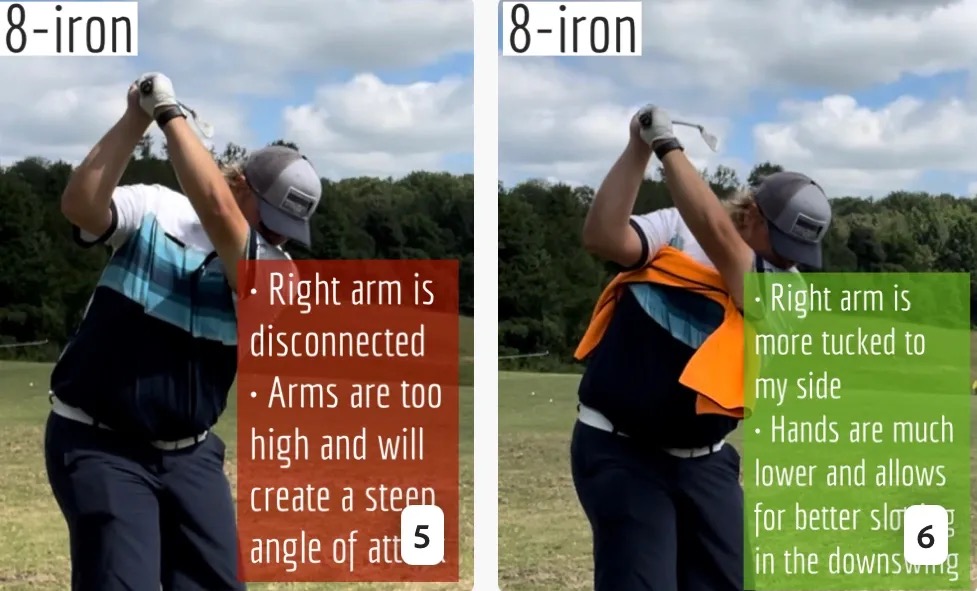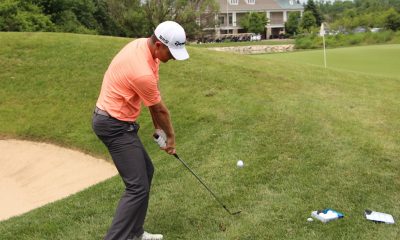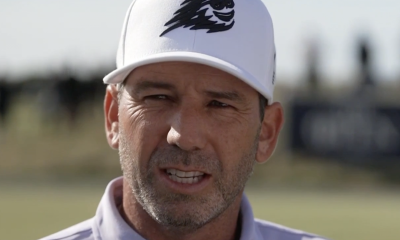Instruction
Kelley: Should a Tour player’s swing be the pattern we copy?

PGA Tour players are the most gifted golfers on the planet. Their ball striking ability is remarkable to the average, even scratch, golfer. With the time to practice all day, usually perfecting their imperfections in their own swings, why are PGA Tour players’ swings always the model we seek?
Look at the progression and expectations in other sports played recreationally. If you start playing Tennis, you don’t expect to serve as fast and accurate as Rafael Nadal. When joining a gym, do we look and replicate the times and bodies of Olympians? However, in golf, players seek the worlds best trying to emulate them. Examining this idea, could this actually be detrimental?
Let’s start with the speed differential. The average PGA Tour driver club head speed is 113 mph. The average male amateur golfer driver speed is 93.4 mph. The average handicap for the male golfer sits between 14 and 15. Below is a chart from Trackman showing the distribution of clubhead speed among male golfers.

*Trackman research shows there is a direct correlation between clubhead speed and handicap.
Speed is mostly a natural talent developed at an early age. It can be enhanced with speed training, gym work and even lifestyle changes. ?With such a differential in speed?, wouldn’t players first be better served focusing on center contact with the most efficient route to do so? This can include modeling simple looking swings.
Besides the speed differential, the world’s best golfers all have unique swings that have been perfected over time. Take for example the top ten players in the world. Different swings with different match-up moves throughout the motion. They have made it work for themselves with countless practice hours. Usually time the average golfer doesn’t have.
A main example would be Rory McIlroy, often a sought out golf swing among students. Here is a quote regarding his swing swing sequence after visiting the Titleist Performance Institute Center. “At the start of McIlroy’s downswing, his left hip spins violently counterclockwise, as it does for every elite, long-hitting player. but then, and only with the driver, Mcllroy makes a funky move you could not teach. a moment before impact, his left hip suddenly changes direction and jerks back, clockwise, and then rotates again.”
With the average golfer on a time constraint?, golfers could actually look at what the greats do the older they get in their careers. The swings become more simple, using their instincts to get their body in efficient and more teachable positions. This is usually in their set-up then backswing, with less excess movement for an efficient strike. Take for example a young versus older Ben Hogan. (Picture below)

Below is another example of a young Jack Nicklaus compared to an older Nicklaus later in his career.

This is in large part due to the concept that less can be more at times. Unfortunately in golf, all to often players are told to do more with their swing, only to jeopardize center contact even seeking vanity over function.
A concept that could be beneficial is next time you want to work on your swing, focus on efficiency and minimizing the ?motion for center contact and a better face/path relationship. Then you can build. Rather then taking a bit from a Tour player’s swing, understand how your body should move to achieve your desired ball flight. Once you have a foundation, then add speed and your own DNA to the swing.
The argument could be made the opposite should be taught for aspiring junior golfers, especially the way the game as going. This article is intended to open a discussion and perhaps change the view of how the golf swing is being taught based on your skill-set and what you are trying to get out of the game. Also, what may be teachable and not teachable. You can change swings with concepts alone.
Twitter: @Kkelley_golf
- LIKE57
- LEGIT14
- WOW3
- LOL0
- IDHT0
- FLOP4
- OB2
- SHANK7
Instruction
Clement: Stop ripping off your swing with this drill!

Not the dreaded headcover under the armpit drill! As if your body is defective and can’t function by itself! Have you seen how incredible the human machine is with all the incredible feats of agility all kinds of athletes are accomplishing? You think your body is so defective (the good Lord is laughing his head off at you) that it needs a headcover tucked under the armpit so you can swing like T-Rex?
- LIKE0
- LEGIT0
- WOW0
- LOL0
- IDHT0
- FLOP0
- OB0
- SHANK1
Instruction
How a towel can fix your golf swing

This is a classic drill that has been used for decades. However, the world of marketed training aids has grown so much during that time that this simple practice has been virtually forgotten. Because why teach people how to play golf using everyday items when you can create and sell a product that reinforces the same thing? Nevertheless, I am here to give you helpful advice without running to the nearest Edwin Watts or adding something to your Amazon cart.
For the “scoring clubs,” having a solid connection between the arms and body during the swing, especially through impact, is paramount to creating long-lasting consistency. And keeping that connection throughout the swing helps rotate the shoulders more to generate more power to help you hit it farther. So, how does this drill work, and what will your game benefit from it? Well, let’s get into it.
Setup
You can use this for basic chip shots up to complete swings. I use this with every club in my bag, up to a 9 or 8-iron. It’s natural to create incrementally more separation between the arms and body as you progress up the set. So doing this with a high iron or a wood is not recommended.
While you set up to hit a ball, simply tuck the towel underneath both armpits. The length of the towel will determine how tight it will be across your chest but don’t make it so loose that it gets in the way of your vision. After both sides are tucked, make some focused swings, keeping both arms firmly connected to the body during the backswing and follow through. (Note: It’s normal to lose connection on your lead arm during your finishing pose.) When you’re ready, put a ball in the way of those swings and get to work.

Get a Better Shoulder Turn
Many of us struggle to have proper shoulder rotation in our golf swing, especially during long layoffs. Making a swing that is all arms and no shoulders is a surefire way to have less control with wedges and less distance with full swings. Notice how I can get in a similar-looking position in both 60° wedge photos. However, one is weak and uncontrollable, while the other is strong and connected. One allows me to use my larger muscles to create my swing, and one doesn’t. The follow-through is another critical point where having a good connection, as well as solid shoulder rotation, is a must. This drill is great for those who tend to have a “chicken wing” form in their lead arm, which happens when it becomes separated from the body through impact.
In full swings, getting your shoulders to rotate in your golf swing is a great way to reinforce proper weight distribution. If your swing is all arms, it’s much harder to get your weight to naturally shift to the inside part of your trail foot in the backswing. Sure, you could make the mistake of “sliding” to get weight on your back foot, but that doesn’t fix the issue. You must turn into your trial leg to generate power. Additionally, look at the difference in separation between my hands and my head in the 8-iron examples. The green picture has more separation and has my hands lower. This will help me lessen my angle of attack and make it easier to hit the inside part of the golf ball, rather than the over-the-top move that the other picture produces.


Stay Better Connected in the Backswing
When you don’t keep everything in your upper body working as one, getting to a good spot at the top of your swing is very hard to do. It would take impeccable timing along with great hand-eye coordination to hit quality shots with any sort of regularity if the arms are working separately from the body.
Notice in the red pictures of both my 60-degree wedge and 8-iron how high my hands are and the fact you can clearly see my shoulder through the gap in my arms. That has happened because the right arm, just above my elbow, has become totally disconnected from my body. That separation causes me to lift my hands as well as lose some of the extension in my left arm. This has been corrected in the green pictures by using this drill to reinforce that connection. It will also make you focus on keeping the lead arm close to your body as well. Because the moment either one loses that relationship, the towel falls.


Conclusion
I have been diligent this year in finding a few drills that target some of the issues that plague my golf game; either by simply forgetting fundamental things or by coming to terms with the faults that have bitten me my whole career. I have found that having a few drills to fall back on to reinforce certain feelings helps me find my game a little easier, and the “towel drill” is most definitely one of them.
- LIKE11
- LEGIT1
- WOW2
- LOL0
- IDHT0
- FLOP2
- OB0
- SHANK8
Instruction
Clement: Why your practice swing never sucks

You hear that one all the time; I wish I could put my practice swing on the ball! We explain the huge importance of what to focus on to allow the ball to be perfectly in the way of your practice swing. Enjoy!
- LIKE0
- LEGIT0
- WOW0
- LOL0
- IDHT0
- FLOP0
- OB0
- SHANK1
-

 Opinion & Analysis2 weeks ago
Opinion & Analysis2 weeks agoThe Wedge Guy: Golf mastery begins with your wedge game
-

 19th Hole6 days ago
19th Hole6 days agoTour pro calls Anthony Kim a ‘f*****g idiot’ following Instagram comeback post
-

 19th Hole1 week ago
19th Hole1 week agoThis Rory McIlroy post-round ‘The Match’ moment is going viral…but all is likely not what it seems
-

 19th Hole1 week ago
19th Hole1 week agoAnthony Kim’s speculated LIV Golf sign-on fee may surprise you
-

 19th Hole3 weeks ago
19th Hole3 weeks ago6-time Euro Tour champ says Patrick Cantlay ‘should be nailed with a huge fine’ over Genesis incident
-

 Whats in the Bag6 days ago
Whats in the Bag6 days agoAnthony Kim WITB 2024 (February)
-

 19th Hole5 days ago
19th Hole5 days agoThe total sum that Sergio Garcia needs to pay in fines if he wants to return to DP World Tour revealed
-

 19th Hole2 weeks ago
19th Hole2 weeks ago‘Yuck’ – Cringe driving range mansplaining incident towards PGA pro goes viral
















Jacque Nickleaux
Jan 22, 2023 at 1:28 pm
I’d say the guy with 20 major wins (US Amateur’s used to count), 19 runner-ups, and 56 top 5’s would be the one you’d wanna copy.
Evan
Jan 22, 2023 at 3:59 am
Nice article Kelvin, a lot of good points. Overall, I see so much focus on speed when the reality is the large majority of golfers would do better focusing on better consistency, control and are finding the sweet spot more often.
Rich
Jan 21, 2023 at 7:27 pm
LPGA players (Not Lexi though) would be better to copy for most golfers.
Similar swing speeds. More efficiency.
Mower
Jan 21, 2023 at 11:04 am
Gonna be a maverick and say: Teach the finishing posture, then work backwards.
Bob Jones
Jan 22, 2023 at 11:51 am
Absolutely.
BenH
Jan 20, 2023 at 6:14 pm
Yes At Dirty Harry used to say “A man’s got to know his limitations”
Funkman
Jan 20, 2023 at 10:47 am
What a stupid article